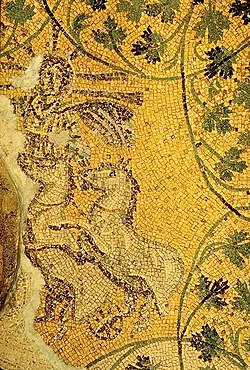This is an old revision of this page, as edited by Speederzzz (talk | contribs) at 23:56, 18 December 2024 (Reverted 1 edit by Sxg169 (talk): That is the title on the website, the title printed inside the book has the months written out in full.). The present address (URL) is a permanent link to this revision, which may differ significantly from the current revision.
Revision as of 23:56, 18 December 2024 by Speederzzz (talk | contribs) (Reverted 1 edit by Sxg169 (talk): That is the title on the website, the title printed inside the book has the months written out in full.)(diff) ← Previous revision | Latest revision (diff) | Newer revision → (diff) Part of the Vatican Necropolis| Tomb of the Julii | |
|---|---|
 Detail of the mosaic Detail of the mosaic | |
| Click on the map for a fullscreen view | |
| General information | |
| Location | Vatican City |
| Coordinates | 41°54′8″N 12°27′12″E / 41.90222°N 12.45333°E / 41.90222; 12.45333 |
The popularly named "Tomb of the Julii" (Mausoleum "M") survives in the Vatican Necropolis beneath St. Peter's Basilica. The serendipitous discovery near the crypt has a vaulted ceiling bearing a mosaic depicting a solar diety with an aureole riding in his chariot, within a framing of rinceaux of vine leaves.
The surrounding Christian iconography, such as other mosaics in this tomb depicting Jonah and the whale, the good shepherd carrying a lamb (the kriophoros motif), and fishermen have led to an interpretation of the deity as Christ, known in this form as "Christus-Sol" or "Christ-Apollo". Due to these symbols, the tomb is interpreted as an early Christian vault. Allen Brent has described it as a "synthesis between Christ and Apollo", in the context of Emperor Aurelian's promotion of Sol Invictus as the chief god of the Roman Empire. According to Brent, Sol Invictus - "with whom Apollo also could be identified" - represented the "shared deity of all individual gods", and the Christian creators of the Tomb of the Julii wished to "express the metaphysical order in the cosmos in terms of a Christian syncretism".
This tomb was first discovered in 1574 when workmen accidentally broke through the ceiling while conducting some floor alterations in the basilica. The inside was briefly explored and documented before the opening was sealed over once more.
See also
References
- Weitzmann, Kurt (1979). Age of spirituality: late antique and early Christian art, third to seventh century; catalogue of the exhibition at the Metropolitan Museum of Art, November 19, 1977 through Febuary 12, 1978. New York, New York, USA: in association with the Princeton University Press. p. 531-532. ISBN 0870991795.
When the artists of the mosaics of the tomb of the Julii under St. Peter's (no.467) portrayed Christ with a rayed nimbus, like Helios in a quadrigia ascending to heaven, he was quoting imagery of Sol Invictus, whose cult was favoured by late Roman Emperors.
- Beckwith, John (1979). Early Christian and Byzantine art (2nd (integrated) ed.). London, England: Penguin Books. p. 19. ISBN 0140560335.
- Brent, Allen (2010). Cyprian and Roman Carthage. Cambridge University Press. p. 229-230.
- Evangelist Walsh, John (1985). The Bones of St. Peter: The First Full Account of the Search for the Apostles Body. Garden City, New York: Image Books. p. 15. ISBN 978-1933184753.
Further reading
- Perler, Othmar 1953, Die Mosaiken der Juliergruft im Vatikan (Universitätsverlag): 34–36